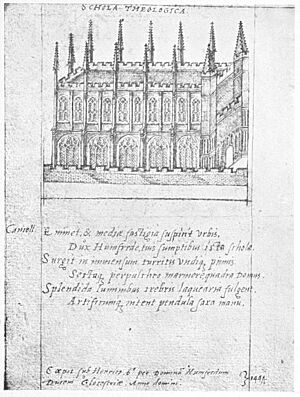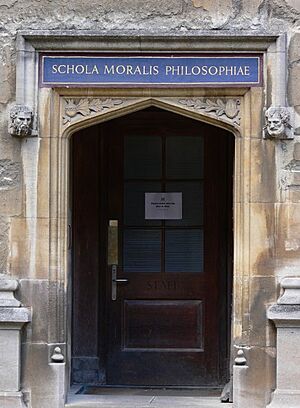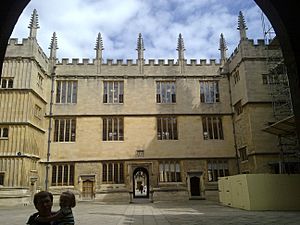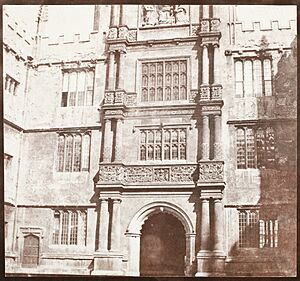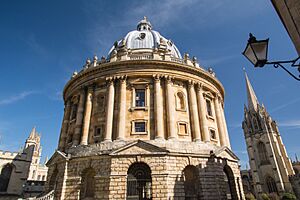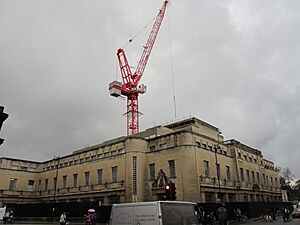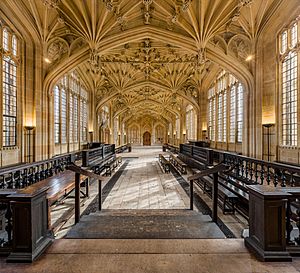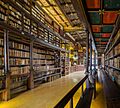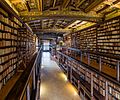Bodleian Library facts for kids
Quick facts for kids Bodleian Library |
|
|---|---|
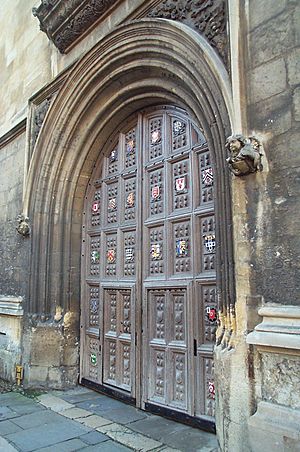 |
|
| Doors to the Bodleian's main entrance, with the coats of arms of several Oxford colleges | |
| Country | United Kingdom |
| Type | Academic library |
| Established | 1602 |
| Location | Broad Street, Oxford |
| Coordinates | 51°45′14″N 1°15′16″W / 51.75389°N 1.25444°W |
| Collection | |
| Items collected | Books, journals, newspapers, magazines, sound and music recordings, maps, prints, drawings and manuscripts |
| Size | 13M+ |
| Legal deposit | Included in the Legal Deposit Libraries Act 2003 |
| Access and use | |
| Access requirements | Old Schools Quadrangle, Divinity School, Exhibition Room and Bodleian Library Gift Shop open to the public |
| Members | Students and fellows of University of Oxford |
| Other information | |
| Director | Richard Ovenden |
The Bodleian Library is the main research library of the University of Oxford. It is one of the oldest libraries in Europe. The library gets its name from its founder, Sir Thomas Bodley.
With over 13 million printed items, it is the second-largest library in Britain. Only the British Library is bigger. The Bodleian is a "legal deposit" library. This means it receives a copy of almost every book published in the United Kingdom. It can also ask for a copy of books published in Ireland.
Oxford students often call it "Bodley" or "the Bod". It's mainly a reference library. This means you usually can't take books out of the reading rooms.
In 2000, many libraries at Oxford University joined together. This group is now called the Bodleian Libraries. The Bodleian Library is the biggest part of this group.
All Oxford colleges have their own libraries. Many of these libraries are even older than the Bodleian. They are separate from the Bodleian. However, most of them use SOLO (Search Oxford Libraries Online). This is the Bodleian Libraries' online catalogue.
Contents
Exploring the Bodleian Library Buildings
The Bodleian Library is made up of five main buildings. They are all located near Broad Street. These buildings include the old 15th-century Duke Humfrey's Library. There's also the 17th-century Schools Quadrangle. The 18th-century Clarendon Building and Radcliffe Camera are part of it too. The newest building is the 20th- and 21st-century Weston Library.
Since the 1800s, the library has built underground storage areas. There's also a large storage facility outside Oxford, near Swindon.
How to Get Inside the Library
To use the library, new readers must agree to a special promise. This promise was once spoken aloud. Now, people usually sign a letter instead. Some people still choose to say the promise aloud. This often happens at the start of the university year.
Visitors who are not part of the university must still say the promise aloud. The Bodleian Admissions Office has many translations of this promise. As of 2017, they had over one hundred languages. This allows people to say the promise in their own language.
The promise in English says:
I hereby undertake not to remove from the Library, nor to mark, deface, or injure in any way, any volume, document or other object belonging to it or in its custody; not to bring into the Library, or kindle therein, any fire or flame, and not to smoke in the Library; and I promise to obey all rules of the Library.
This is a translation of the old Latin promise. The original Latin version did not mention smoking. This is because tobacco smoking was not common then. Libraries also didn't have heating, as fires were too dangerous.
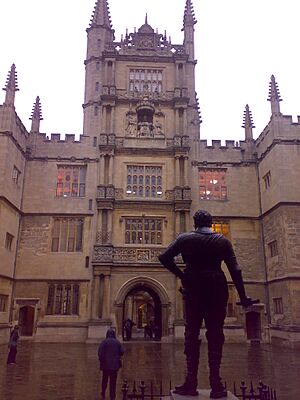
The Tower of the Five Orders, seen from the Divinity School.

The Library seen from Radcliffe Square.
|
A Look at the Library's History
Early Days: 14th and 15th Centuries
The Bodleian Library we know today started in 1602. But its roots go back much further. The first library building in Oxford was created in the 1300s. It was funded by Thomas Cobham, a bishop. This small collection of chained books was above the University Church of St Mary the Virgin.
The collection grew steadily. Then, Humphrey, Duke of Gloucester (brother of Henry V of England) gave many manuscripts. This happened between 1435 and 1437. The old space was too small. So, a bigger room was built above the Divinity School. This room was finished in 1488. It is still known as Duke Humfrey's Library. After 1488, the university stopped caring for the library. Books began to disappear.
Sir Thomas Bodley Reopens the Library
The library fell into disuse in the late 1500s. Its furniture was sold. Only three of Duke Humphrey's original books remained. During the time of Edward VI, many Catholic-related manuscripts were destroyed.
The library began to thrive again in 1598. This was when Thomas Bodley offered to help. He wrote to the university, promising to restore the library. Bodley was a former student of Merton College. He had recently married a rich widow. His father was a Protestant merchant.
Six Oxford professors helped Bodley fix up the library. Duke Humfrey's Library was renovated. Bodley also gave some of his own books. The library officially reopened on November 8, 1602. It was named the "Bodleian Library." At this time, it had about two thousand books. A special book was displayed to encourage more donations. People wanted to donate books to keep them safe after the Reformation.
Bodley collected many different types of items. By 1603, he was trying to get manuscripts from Turkey. The first Chinese book was bought that same year. In 1605, Francis Bacon gave the library a copy of The Advancement of Learning. He called the Bodleian "an Ark to save learning from deluge."
At first, there were few English books. This was because academic work was not done in English. In 1610, Bodley made a deal with the Stationers' Company. They agreed to send a copy of every book they printed to the library. The Bodleian collection grew very quickly. The building was expanded between 1610 and 1612. It was expanded again from 1634 to 1637. When John Selden died in 1654, he left his large collection of books to the Bodleian. This part of Duke Humfrey's Library is now called the "Selden End."
By 1620, the Bodleian had 16,000 items. Anyone who wanted to use the library had to buy a copy of its catalogue. It cost 2 shillings and 8 pence.
The Schools Quadrangle and Tower of the Five Orders
When Bodley died in 1613, a new expansion was just starting. The Schools Quadrangle was built between 1613 and 1619. It added three wings to the existing library. Its tower is the main entrance to the library. It is called the Tower of the Five Orders.
The tower gets its name from its decorations. It has columns from five different styles of classical architecture. These are the Tuscan, Doric, Ionic, Corinthian, and Composite styles.
The three wings of the quadrangle have three floors. The rooms were first used for lectures and an art gallery. The lecture rooms still have signs above their doors. As the library grew, these rooms were taken over by books. University lectures moved to a new building. The art collection went to the Ashmolean museum. Now, some rooms are offices, meeting rooms, or a gift shop. One room used to show library treasures. These are now in the renovated Weston Library.

Later Years: 17th and 18th Centuries
The agreement with the Stationers' Company meant the library kept growing. Many large collections were also donated. Until the British Museum opened in 1753, the Bodleian was like England's national library. It was one of the biggest book collections in England.
In 1769, the astronomer Thomas Hornsby watched the transit of Venus from the Tower of the Five Orders. In 1817, a large collection of medieval Italian manuscripts was bought. In 1829, the library bought a collection from Rabbi David Oppenheim. This added to its Hebrew collection.
The Radcliffe Camera
By the late 1800s, the library needed more space. In 1860, the Bodleian was allowed to use the nearby Radcliffe Camera. In 1861, the library's medical and science books moved. They went to the Radcliffe Science Library. This library was built near the University Museum.
The Clarendon Building
The Clarendon Building was designed by Nicholas Hawksmoor. It was built between 1711 and 1715. It first held the printing presses of the Oxford University Press. The Press moved out in the early 1800s. The university then used it for offices. In 1975, it became part of the Bodleian Library. Now, it has offices and meeting rooms for senior staff.
20th Century and Beyond
In 1907, the head librarian began to update the book catalogue. In 1909, the prime minister of Nepal donated many Sanskrit books.
In 1911, the Copyright Act continued the agreement with the Stationers' Company. This made the Bodleian one of the libraries that must receive a copy of every book published in the UK.
Between 1909 and 1912, an underground book storage area was built. It was under the Radcliffe Camera and Radcliffe Square. It is now called the Gladstone Link. By 1914, the library had over 1 million books. During World War I, many library staff joined the war effort. The catalogue update slowed down. In 1915, the most valuable books were moved to a secret place. This was because of fears of bombing. Luckily, Oxford was not bombed.
By the 1920s, the library needed more space. In 1937, construction began on the New Bodleian building. It is across from the Clarendon Building on Broad Street.
The New Bodleian was designed by Sir Giles Gilbert Scott. It was finished in 1940. The building had an interesting design. 60% of its book storage was underground. A tunnel under Broad Street connects the old and new buildings. It has a walkway for people. It also had a mechanical book conveyor and a system for sending book orders. This system was used until 2002. The old system was turned off in 2009. In 2010, the book conveyor was also shut down. The New Bodleian closed in 2011 for major renovations.
The Libraries Today and Tomorrow
The New Bodleian building was rebuilt behind its original front. It now has better storage for rare books. It also has improved facilities for readers and visitors. The new building was designed by WilkinsonEyre. It reopened as the Weston Library on March 21, 2015.
In March 2010, the group of libraries was renamed "The Bodleian Libraries." This helped all Oxford libraries benefit from the Bodleian's famous name. The building was nominated for a design award in 2016.
In November 2015, the library's collection grew to over 12 million items. This happened when they acquired Shelley's "Poetical Essay on the Existing State of Things." This poem was thought to be lost for a long time. The Bodleian has made it available online.
Copying and Protecting Library Materials
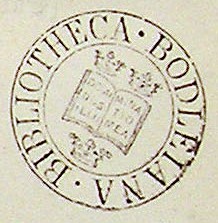
The library has strict rules about copying materials. In the past, you couldn't photocopy library items yourself. This was to prevent damage. Now, you can copy most items made after 1900. For older materials (1801-1900), staff can help you copy them. You can also use handheld scanners and digital cameras for most post-1900 books. With permission, you can use digital cameras for older items too.
The library can provide digital scans of most materials from before 1801. Many fragile items have been copied onto Microform. These copies are used instead of the originals whenever possible. The library also shares digital images of its collection online through its Digital Bodleian service.
Amazing Treasures of the Library
Manuscript Collections
- The Ashmole Manuscripts, collected by Elias Ashmole. These include the Ashmole Bestiary.
- The Carte Manuscripts, collected by Thomas Carte.
- The Douce Manuscripts, given by Francis Douce in 1834.
- The Laud Manuscripts, given by Archbishop William Laud.
- Letters from the poet Percy Bysshe Shelley.
- The Drower Collection, the world's largest collection of Mandaean manuscripts.
Special Individual Manuscripts
- Abingdon Missal, a beautiful manuscript from the 15th century.
- Ashmole Bestiary, an English manuscript with descriptions of over 100 animals (12th Century).
- Bakhshali manuscript, Bower Manuscript, and Weber Manuscript of ancient Sanskrit texts (4th-6th Centuries).
- Bruce Codex, a Coptic manuscript with gnostic writings (6th Century).
- Bujangga Manik, an early palm-leaf manuscript from Java (15th Century).
- Cædmon's Hymn, a short Old English poem (11th Century).
- Codex Bodley, a rare pre-Columbian picture manuscript (14th-15th Centuries).
- Codex Ebnerianus, a Greek illuminated New Testament manuscript (12th Century).
- Codex Laudianus, a Greek New Testament manuscript (6th Century).
- Codex Laud, a pictorial manuscript from Central Mexico (16th Century).
- Codex Mendoza, an Aztec manuscript about Aztec rulers and conquests (16th Century).
- Codex Selden, a pre-Columbian picture manuscript (16th Century).
- Codex Tischendorfianus III and Codex Tischendorfianus IV, Greek Gospel manuscripts (9th-10th Centuries).
- Book of Hours of Engelbert of Nassau, an illuminated manuscript (15th Century).
- The Fairfax MS 16, a Middle English poetry collection (15th Century).
- Book of Glendalough, an important Irish manuscript (12th Century).
- Hebban olla vogala, an old Dutch text (12th Century).
- Four fragmented scrolls from the Herculaneum papyri that survived the Mount Vesuvius eruption.
- The Huntington MS 17, the oldest complete text of the Gospels in Coptic (12th Century).
- Annals of Inisfallen, a history of medieval Ireland (11th Century).
- Kennicott Bible, a beautiful Hebrew illuminated manuscript from Spain (15th Century).
- Leofric Missal, an illuminated manuscript from Lotharingia (10th-11th Centuries).
- Hours of Louis Quarré, an illuminated manuscript (15th Century).
- Ormesby Psalter, a magnificent English illuminated manuscript (14th Century).
- Peterborough Chronicle, one of the Anglo-Saxon Chronicles (12th Century).
- Illuminated Gospel Book of Saint Margaret of Scotland (11th Century).
- Selden Roll, a Mexican painted manuscript roll (16th Century).
- Magna Carta, four of the existing copies (13th Century).
- Oldest copy of the Rule of Saint Benedict (8th Century).
- The Song of Roland, the oldest surviving major French literature work (12th Century).
- Rushworth or MacRegol Gospels, an Irish illuminated manuscript (9th Century).
- The Vernon Manuscript, the longest and most important Middle English manuscript (15th Century).
- Yongle Encyclopedia, 19 volumes of a huge Chinese encyclopedia (16th Century).
Rare Printed Books
- The first book printed in Arabic using moveable type (16th Century).
- Bay Psalm Book, one of the first books printed in North America (1640).
- A rare copy of The Birds of America by John James Audubon (1827–1838).
- A rare first edition of Don Quixote, considered the first modern novel (1604).
- A Gutenberg Bible, one of only 21 complete copies (1455).
- Shakespeare's First Folio, a collection of plays by William Shakespeare (1623).
- The earliest edition of the song Yankee Doodle (after 1775).
Other Special Items
- Agincourt Carol, a manuscript of an English folk song about the Battle of Agincourt (15th Century).
- The Gough Map, a medieval map of Great Britain (14th Century).
- Selden Carol Book, a medieval manuscript of English carols (15th Century).
- Manuscripts from famous authors like Jane Austen, Kenneth Grahame (including Wind in the Willows), Franz Kafka, CS Lewis, John le Carré, Mary Shelley (including Frankenstein), Percy Shelley, and JRR Tolkien.
- The archive of German composer Felix Mendelssohn, with his letters, drawings, and music. This includes the Hebrides overture.
- Original music scores by famous composers like Beethoven, Chopin (Ballade 4), Mozart, and Schubert (Sonata in C major for piano four-hands, D 812).
- Shikshapatri, a religious text in Sanskrit by Swaminarayan (19th Century).
Who is Bodley's Librarian?
The person in charge of the Bodleian Library is called "Bodley's Librarian." The first librarian, Thomas James, was chosen by Bodley in 1599. The university confirmed him in 1602. Bodley wanted his librarian to be a "diligent Student" and "trusty, active, and discreet." He also wanted someone who was a graduate and knew languages. Bodley preferred someone unmarried and without another job. However, James convinced Bodley to let him marry and become a church rector. James said of the Bodleian, "The like Librarie is no where to be found."
In total, 25 people have been Bodley's Librarian. Some were very dedicated, while others were not. For example, Thomas Lockey (1660–1665) was not considered good for the job. John Hudson (1701–1719) was described as "negligent." John Price (1768–1813) was accused of "constant neglect."
Sarah Thomas was the first woman to hold the position. She served from 2007 to 2013. She was also the first American librarian to lead the Bodleian. Her successor, Richard Ovenden, became librarian in January 2014. He had been the Deputy Librarian under Sarah Thomas.
Images for kids
See also
 In Spanish: Biblioteca Bodleiana para niños
In Spanish: Biblioteca Bodleiana para niños
- Books in the United Kingdom
- Codex Baroccianus
- Convocation House
- Digby Mythographer
- European Library
- Google Books
- Michael Shen Fu-Tsung


